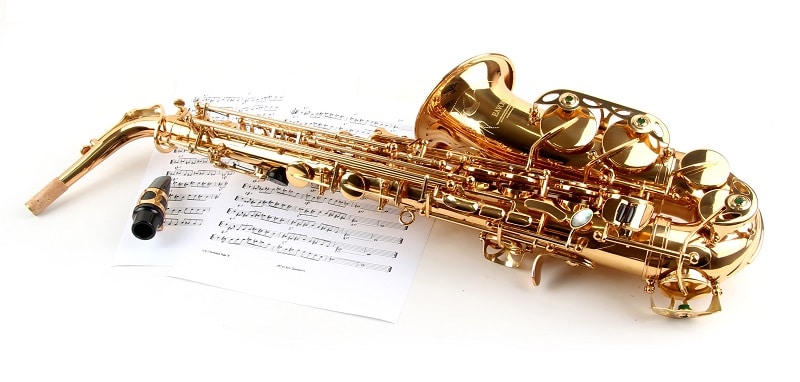If you want to play the saxophone, you’ll need to read music.
With multiple clefs out there, you should consider the different types of saxophones and which clefs they use.
Here’s Whether Saxophones use Treble or Bass Clef:
Saxophones use the treble clef for their standard music. That includes the soprano all the way down to the contrabass saxophone. However, it helps to read the bass clef, especially if you want to play music originally written for other instruments.
Table of Contents

Overview of Clef per Saxophone
When you start learning the saxophone, you may need to learn to read music.
This is particularly true if you’ve never learned any other instrument, but the saxophone may not use the same clef even if you’ve learned an instrument.
Here’s what you need to know about the clefs that each saxophone uses:
Soprano Saxophone
The soprano saxophone reads music in treble clef.
Out of all of the saxophones, the soprano sounds closest to the written notes, but it still sounds a bit lower.
Is The Soprano Saxophone Hard To Learn? (Explained)
Alto Saxophone
Alto saxophones also read music in the treble clef and share the same written range as the soprano.
However, they sound a perfect fifth lower than the soprano sax.
Tenor Saxophone
Despite its sounding range being well within the bass clef, tenor sax music uses the treble clef.
This helps make it easy to switch between the saxophones.
Is The Tenor Saxophone Hard To Learn? (Explained)
Baritone Saxophone
The bari sax has the same sounding range as the cello, which uses the bass clef.
However, like all other saxophones, the baritone reads music in treble clef and sounds an octave lower than the alto sax.
Is The Baritone Saxophone Hard To Learn? (Explained)
Bass Saxophone
You may think, “the bass saxophone has to use the bass clef, right?”
For better or worse, music written for the bass sax still uses the treble clef.
Contrabass Saxophone
“Okay, well wouldn’t the contrabass saxophone use the bass clef?”
Regardless of how it can play the same pitch as the lowest Db on a piano, music for the contrabass sax is in the treble clef.
How Come Even Bass and Contrabass Saxophones Are Treble Clef?
Bass and contrabass saxophones use the treble clef to help saxophonists switch between the instruments.
You can use the same written range of notes no matter what size of saxophone you’re playing.
That makes it a lot easier to learn and double on multiple saxophones. The bass and contrabass saxes are relatively rare, so you may never own one.
You’ll have limited practice time if you need to play a bass or contrabass part.
Instead of learning to read a new clef, you can focus on using enough air to produce a sound on the massive saxophones.
Are All Woodwind Instruments Treble Clef?
Most woodwind instruments use the treble clef in some capacity.
It’s the only clef you’ll use when reading music for the saxophone, clarinet, flute, and oboe.
However, the primary clef for the bassoon and contrabassoon is the bass clef. These instruments read music in concert pitch or an octave below, respectively.
Like low brass instruments, the bassoon can also use the tenor clef and even the treble clef.
I played a chamber piece with a bassoonist in college, and the bassoon part went well up into the treble clef.
Despite the wide variety of sounding ranges, the fact that most woodwinds use the treble clef is useful. You can easily double on saxophones, clarinets, and flutes without learning how to read more notes.
Plus, those instruments also share a lot of the same fingerings. That makes switching between the instruments even easier.
Are All Brasswind Instruments Treble Clef?
Not all brass instruments use the treble clef. The trumpet, French horn, and cornet use the clef as the main way to notate and read music.
On the other hand, the trombone and tuba primarily use the bass clef with the occasional tenor clef.
When it comes to advanced trombone music, it’s also not unexpected to see some treble clef parts.
The euphonium can use either the treble or bass clef, making learning easier after learning another brass instrument. That way, you’ll have one less thing to learn if you want to learn a low brass instrument.
When the euphonium reads music in the bass clef, it will be in concert pitch.
I don’t know why, but treble parts for the euphonium are in Bb, so they sound a major second lower than written.
How Do You Transpose From Bass to Treble Clef?
Being able to transpose between clefs is useful if you want to play music for other instruments on your saxophone.
The easiest way to do this is to read the bass clef as if it’s the treble clef.
You’ll need to add three sharps if you have music written in bass clef. Then, you can read the music like you’re reading a treble clef part, and it will sound correct.
This trick is especially useful if you want to play a trombone or cello part on the bari sax.
Because of how the bari sax transposes, it will sound exactly the same, with no worries about octave transpositions.
Of course, you can also transpose the music from the treble to the bass clef. To do so, you’ll need to add three flats, and then, you can read the notes and have them sound in tune.
Regardless of which way you transpose, take extra care when you see accidents.
They shouldn’t be hard often, but it gets tricky when you have multiple sharps and flats in the key signature.
Final Thoughts
Standard saxophone music uses the treble clef, regardless of how high or low the saxophone’s sounding range is.
You only have to learn one set of written notes and fingerings as a player.
Then, you can switch between the soprano, alto, tenor, bari, bass, and contrabass saxes.
